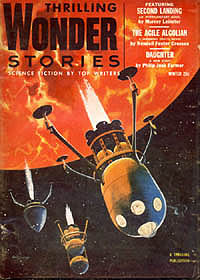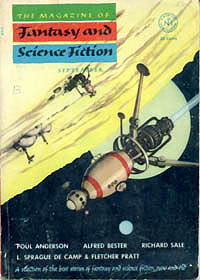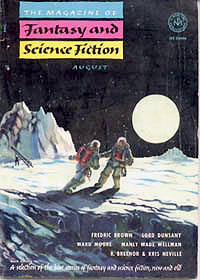Jack Coggins - Internet References
This page shows references to Jack Coggins's work on other web sites. The link is given before each item.
I have added these here rather than just showing the link, because sometimes the information is moved or disappears over time, leading to a dead link.
This website is a tribute to Jack, and the text is provided for information only; if any of the web site owners have any problem with the use of this information, please email me and I will remove it.
https://er.jsc.nasa.gov/seh/sfcraft.html
Planetary Landers: Jack Coggins (1954)

DISCUSSION
The picture shows three types of planetary landers. The Jack Coggins' "Thrilling Wonder Stories" Winter 1954 cover portrayed the categories of spacecraft which would ultimately serve to land on the Moon. The largest of the vehicles is much like the Grumman designed Apollo Lunar Module, as is the lower center lander. However, the lander drawn to the far lower left features an Apollo-like Command Module capsule design with the addition of landing struts. Such vehicles could also land on other planets or their satellites. Each vehicle utilizes multiple (clustered) rocket engines. Such configurations provide a safety margin should a single rocket fail. Additionally, Coggins shows multiple propellant tankage for both fuel and oxidizer. Again, redundancy offers reliability and safety, factors considered in the design of the Apollo lunar lander.
Coggins correctly depicts crew modules as somewhat streamlined structures for entry into planetary atmospheres. No such requirement existed for the Apollo lander's touchdown on the airless vacuum of the Moon. Happily, Coggins provides a communication antenna and adequate viewing ports for the crew. The planet in the background is apparently Mars (depicted in hues of red).
Study of the above cover painting reveals two interface seams across the large vehicle. This indicates three stages of approximately the same size. Such a design would provide for: an Apollo lunar module-like descent stage which would remain on the planet after ascent stage lift off, a support module for consumables (supplies) similar to the Apollo Service Module (SM), and finally, a capsule-like crew station module for Earth atmospheric re-entry.
Such a configuration, drawn seven years before the American single astronaut Mercury spacecraft, exhibits a keen knowledge of spacecraft design. Examination of the rocket plume in the painting brings forth questions about the craft's design. Note that the outboard cluster of engines is dormant while a core engine provides thrust. The extended landing gear indicates all three vehicles are, most likely, descending for a planetary touchdown. In such a case, the outboard engines would probably be for ascent. Using the outboard engines for ascent leads to the conclusion that the descent stage is not left on the planet but is reused. On the other hand, the outboard engines may have served as "OTV" (orbital transfer vehicle) propulsion between planets. If this is the case, they will remain on the planet after touchdown with the descent stage.
Reversing the scenario shown in the cover art scene leads to the conclusion that the artwork portrays ascent rather than descent and the outboard engines might have served as descent propulsion as well as OTV rocketry. In either case, the artist may not have considered the utility of leaving the landing gear, etc. on the planet surface, as did the Apollo Lunar Module (LM). Finally, note the mechanical design of the landing gear. Foot shocks appear automotive. Perhaps, strut shock absorbers in the lower stage help cushion planetary landings.
Fantasy Science Fiction (September 1953 Issue)

DISCUSSION
The artwork is a rendering of a "space ship over base on Ariel, Uranus in background." The artist is Jack Coggins. The remarkable aspect of the above picture is its likeness to the Apollo Lunar Excursion Module of the 1960s.
The engine and four landing legs appear to be part of a descent stage structure. The ball-like ascent stage sits atop the vehicle much like the lunar lander's ascent stage. Additionally, the lander's legs are hinged for deployment prior to landing much like the Apollo lander's gear was deployed after it was unstowed from the Saturn V launch/ferry configuration. Even the positioning of a parabolic antenna on the ascent stage is similar to the Grumman built Lunar Excursion Module (LEM). Unfortunately, the artist has neglected to include orientation thrusters which enabled Neil Armstrong and Edwin Aldrin to land safely on the Moon.
Fantasy Science Fiction (August 1953 Issue)

DISCUSSION
The cover by artist Jack Coggins is titled "Erecting a communications tower on Triton; Uranus in background." Incidentally, Triton is a satellite of Neptune not Uranus. Triton is approximately the size of the Earth's Moon such that gravity might approximate that of the Moon. The significant concept depicted in the painting is the use of the principles of simple machines to erect the communications tower. Using Triton's surface as the fulcrum, the two astronauts lever the tower into position. A third astronaut applies a moment force to assist in the erection of the tower.
Source: www.noreascon.org

Three artists who concentrated on astronautical/astronomical subjects appeared on the major magazines and elsewhere. Chesley Bonestell, renowned for his space travel and scientific images in Life, Collier's, and Scientific American, had fifteen appearances on the SF magazines since late 1947 - seven on Astounding, five on F&SF, and three on Galaxy. However, his only magazine cover in 1953 was a pretty view of the old Mars from a craggy Phobos on the March F&SF, though he also had a planetary landscape on the jacket of The Best from F&SF #2.
More significantly, this was the year Cornelius Ryan's Conquest of the Moon was published by Viking Press (recast from the Collier's series of the year before), containing seven breathtaking realizations by Bonestell of an expedition to the Moon, exploring its surface, and establishing a base. These paintings, with their sweeping vistas and deep perspectives, set a high water mark at which other astronautical artists would aim.
Jack Coggins and Mel Hunter were two others of this ilk. Coggins had three covers on F&SF (May, Aug., and Sept.), three more on Thrilling Wonder (Feb., Apr., and Aug.), and one on Science Fiction Quarterly (Nov.). On the whole Coggins's renderings were painted in a more rough-hewn style than Bonestell's; even so, they brimmed with raw vitality and a strong sense of adventure, and were no less concerned with pragmatic engineering details. His art often focused in tight on spacemen at work, doing the real labor of mining, hauling, and construction; and his space vehicles and equipment typically looked as if professional mechanics had hammered and bolted them together.
All Artworks Copyright © Jack Coggins